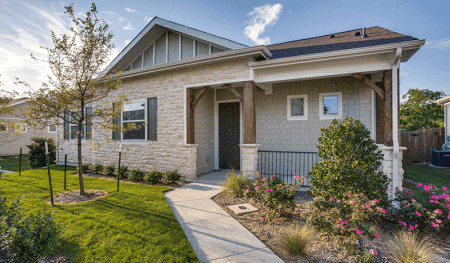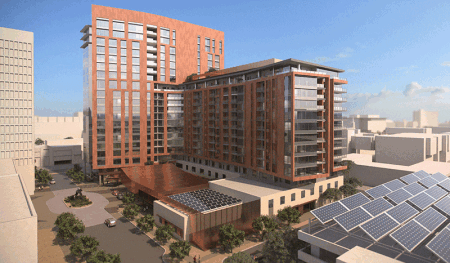As one of the fastest growing and most populous metropolitan areas in the United States, the Phoenix metro area has seen some 40,000 apartments built since 2010, with demand and prices continuing to rise. Panelists for “Future of Housing: Finding the Right Fit for Changing Demographics,” at the ULI Arizona Trends Day session held recently at the JW Marriott Phoenix Desert Ridge, provided a glimpse of how different product types are filling needs for the housing-strapped region.
Having developed over 3,500 mostly urban infill homes in the region over the past 22 years, including the new 89-unit luxury Envy condominiums in downtown Scottsdale, Deco Communities of Scottsdale is “focused now on attainable apartments” because of the great need for workforce housing, said Patricia Watts, senior partner and director of planning.
“The average rental household income is only $40,000 per year, and many renters are moderately or severely rent-burdened, with little or no ability to do anything but pay rent,” said Watts. “We challenged ourselves a year ago to build a product that will rent for $1,000 per month,” which is an attainable rent level for a single person earning a $40,000 income, a couple earning minimum wage, or a senior on retirement income. She said Deco Communities will open 600 units in the next two years, including 226 apartments at the Cabana on Washington, located on the Washington Street Corridor, a main connector between Tempe, Arizona State University (ASU), and downtown Phoenix.
“Site selection is challenging, and we try to find entitled sites,” said Watts. “For us, time is money to deliver product as inexpensively as possible. We can’t control the time the city takes for approvals. We encourage cities to reduce the unknown and the number of levels of the approvals process for attainable housing.” She said that cities on board for attainable housing are using self-certified drawings—where architects certify that their drawings meet code—to expedite the process.
Compared with homebuilding a decade ago, said Josh Hartmann, president and CEO of NexMetro Communities in Phoenix ,“today I see many groups developing different products,” as well as more competition and innovation. With 1,300 homes completed and 1,600 under construction in the Sun Belt, NexMetro is building “hybrid” smaller rental homes, ranging from 650 to 1,200 square feet (60 to 111 sq m), at 12 units per acre (30 units per ha) on its 10-acre (4 ha) development sites, he said. The one-level homes have small yards and full on-site maintenance and property management. According to a recent RCLCO study on NexMetro’s demographics, the average renter is age 25 to 35, making $50,000 to $100,000 in income per year, or is at retirement age, said Hartmann.

NexMetro is building “hybrid” smaller rental homes across the U.S. Southwest, ranging from 650 to 1,200 square feet (60 to 111 sq m), at 12 units per acre (30 units per ha) on its 10-acre (4 ha) development sites The one-level homes have small yards but full on-site maintenance and property management. (NexMetro)
“Buyers want a maintenance-free lifestyle,” said Hartmann. “On the millennial side, they’re people who don’t know if they want to stay in Phoenix, have a lot of student debt, or don’t want to buy a house yet. On the senior side, they’re buyers who don’t need a large home anymore and want easy care.”
NexMetro’s hybrid model is based on multifamily zoning with variances to allow for single-story detached homes. The firm is building similar housing in Dallas, Denver, and Tampa, he said. One challenge is that sites “tend not to be zoned for our product,” except in Phoenix, where zoning rules allow it. “It’s a long process of educating on how our model works. We show models of previous projects, so cities are getting more comfortable with our product.”
University Realty LLC is joint venture partnering with Pacific Retirement Services (PRS) of Medford, Oregon, to build Mirabella at ASU, a 20-story “life plan” community that includes independent living, assisted living, memory care, and skilled-nursing facilities, said Randy Levin, CEO and managing director. Located on ASU’s Tempe campus, Mirabella includes 252 independent-living apartments and 52 health care units, as well as an indoor pool, a theater, an art museum, a spa, a dog park, and four restaurants. The upscale project is scheduled to be completed in 2020. Some 217 one- and two-bedroom units have been reserved for still-working and retired residents who will teach, take classes, or mentor at the university, Levin said. PRS has built similar projects in Seattle and at the University of California, Davis.
“Our residents are planners and don’t want to be a burden to their children” and desire an active, urban, lifelong-learning lifestyle, said Levin. “Most have no mortgages on their homes, and don’t have to sell them to pay the entry fee,” he said, which historically was one of the downfalls of this industry niche, also called continuing care retirement communities (CCRCs). Mirabella was built with tax-exempt bonds, so the financial model is different than what other housing developers use, he said. The not-for-profit model, which raises revenues for the mission of ASU, allows seniors to pay an entry fee and a monthly per-unit fee to cover home-maintenance expenses and to transition to higher levels of care, with up to 90 percent of their investment passed on to heirs when they die.
Hartmann said that NexMetro’s average rent-to-income ratio is 28 percent. He identified current risks for developers: “As macro-economic factors change, will there be funding from banks or debt funds to build these? The biggest risk is the unknown in capital markets, so we’re changing to long-hold to build a balance sheet, holding [properties] 10 years or more to give us a hedge against changes in the economy, rather than holding for only four years.”
“We’ve cracked the code on our product,” said Watts. “Competition is good because this niche requires so many units.” However, “paycheck insecurity” is a hazard. “When we’re renting attainable housing with federal employees, which used to be considered great credit, now we can’t collect the rent. It’s a new risk our industry is facing.”

